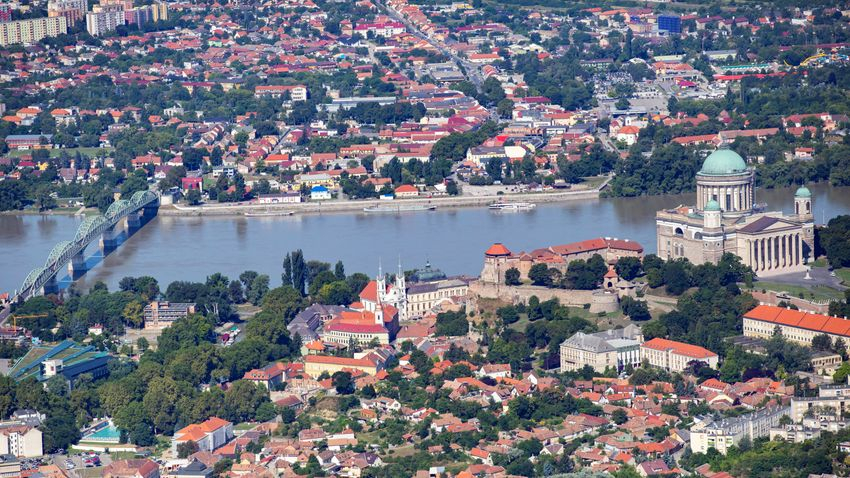
Esztergom / Štúrovo and their environs

ESZTERGOM
Esztergom is a developed industrial city located on the right bank of the Danube in the Central Transdanubian region, in Komárom-Esztergom county. Birthplace and coronation city of St. Stephen. Esztergom is the center of the Hungarian Catholic Church, the seat of the Archdiocese of Esztergom. A city with excellent tourism facilities. During the Árpád era, it was the capital of Hungary, the seat of Esztergom county, later Komárom-Esztergom county until 1950. Geographically, Esztergom is located west of the Visegrád Mountains, at the foot of the Pilis Mountains, on the right bank of the Danube, 40 km from Budapest. It is also called the highest city of the Danube Bend. Esztergom was also inhabited in prehistoric times. The Romans also established a settlement here, called Salvio Mansio. After the arrival of the Hungarians, the city was founded by Grand Duke Géza around 972. By the 15th century, Esztergom had grown into a religious and cultural center.
There is a unique amount of cultural and historical attractions in Esztergom.
- Búbánatvölgy - lies on the border of the Danube-Ipoly National Park, in the valley between Szamár-hegy and Hosszú-hegy. The northern borders of Búbánatvölgy are highway 11 and the Danube. Búbánatvölgy, located approximately 5 kilometers east of the central inland area, is one of the places with the cleanest air in Hungary. There are several small and large lakes in the valley.
- Aquasziget – Esztergom experience spa and wellness center
- Mária Valéria bridge - which connects Esztergom with Párkány in Slovakia. The bridge, completed in 1895, is 518 meters long and 12 meters wide.
- Esztergom Castle - The more than 50-meter high Esztergom Castle stands on a hill rising on the right bank of the Danube, bordered by precipitous side walls. It is considered one of the main attractions of Esztergom, together with the Basilica.
- Esztergom Basilica - built between 1822 and 1869 in classicist style. This is the largest church in Hungary, the cathedral of the Hungarian Catholic Church.
- Lake Palatine
- Grid church
- Danube Museum
- Little Danube promenade
PÁRKÁNY
Párkány is a town in Slovakia, in the Érsekújvár district of the Nitra district.
It lies opposite Esztergom, on the left bank of the Danube. The city of nearly 11,000 inhabitants and its borders are located at the left end of the Danube plain, at the intersection of the fault line of the Garami and Ipolyi loess tables.
To the northeast of the city are the volcanic rocks of the Kovácspataki Mountains (known as 'Burda' in Slovakia), whose highest peak is the 395 m high Keserős Mountain. The city is bordered in the northwest by the Hegyfarok nature reserve, the wine-growing area of the locals.
The average annual temperature is +10.8 C, moderate wind conditions prevail. The Danube, Garam and Ipoly have a favorable effect on the microclimate.
Population
- In 1910, out of 3,079 inhabitants, 3,016 were Hungarians (97.95%).
- In 1991, of its 13,347 inhabitants, 9,804 were Hungarians (73.46%), 3,310 Slovaks (24.8%), 172 Czechs and 30 Gypsies.
- In 2003, of its 11,410 inhabitants, there were 8,049 Hungarians (70.55%), 3,294 Slovaks (28.9%), 137 Czechs (1.2%) and 40 Gypsies. 9,037 are Roman Catholic.
- In 2011, of its 10,919 inhabitants, 6,624 were Hungarian, 2,930 Slovak, 90 Czech, 21 Gypsy, 30 other and 1,202 of unknown nationality.
Sights
- The boat bridge connecting the city with Esztergom was erected in 1842 by Archbishop József Kopácsy of Esztergom, the Mária Valéria bridge built in its place was blown up in 1944 by the retreating Germans. The bridge was rebuilt in 2000-2001 as a result of the Hungarian-Slovak intergovernmental agreement.
- During the summer months, one of the largest thermal spas in Slovakia (with 8 outdoor and indoor pools), the 24-hectare Vadas thermal spa, provides relaxation for thousands of vacationers. The well drilling work that began in 1973 revealed thermal water with a temperature of 39.7 C.
- Notable fairs include the Simon-Júda-vásár in Párkán. In recent decades, the famous big autumn fair in Párkány has become attractive again: many people from Hungary pass through, not only from Esztergom, but also from more distant regions. There are more and more buffet tents, entertainment options, and sophisticated crafts and folk art works.
- III. Bronze equestrian statue of the Polish King John. The statue was created as a result of a decade and a half of organizational work, the beginnings of which are linked to the names of the visual artist Gyula Barta and Gyula Bartusz. The monument raised from public donations was inaugurated in October 2008, on the 325th anniversary of the Battle of Párkány. In 2009, the Polish Minister of National Defense honored Erzsébet Dániel, the president of the Sobieski statue committee, with the Golden Medal, the highest national defense award that can be awarded to foreigners.
- Párkáni City Museum: city history and ethnographic collection, temporary exhibitions.